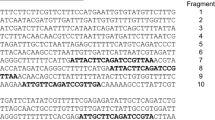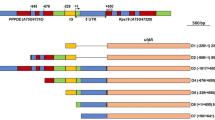Abstract
We have isolated and determined DNA sequence for the 5′-flanking regions of three Arabidopsis thaliana polyubiquitin genes, UBQ3, UBQ10, and UBQ11. Comparison to cDNA sequences revealed the presence of an intron in the 5′-untranslated region at the same position immediately upstream of the initiator methionine codon in each of the three genes. An intron at this position is also present in two sunflower and two maize polyubiquitin genes. An intron is also found in the 5′-untranslated regions of several animal polyubiquitin genes, although the exact intron position is not conserved among them, and none are in the same position as those in the higher plant polyubiquitin genes. Chimeric genes containing the 5′-flanking regions of UBQ3, UBQ10, and UBQ11 in front of the coding regions for the reporter enzyme Escherichia coli β-glucuronidase (GUS) were constructed. When introduced transiently into Arabidopsis leaves via microprojectile bombardment, all resulted in readily detectable levels of GUS activity that were quantitatively similar. The introns of UBQ3 and UBQ10 in the corresponding promoter fragments were removed by replacement with flanking cDNA sequences and chimeric genes constructed. These constructs resulted in 2.5- to 3-fold lower levels of marker enzyme activity after transient introduction into Arabidopsis leaves. The UBQ10 promoter without the 5′ intron placed upstream of firefly luciferase (LUX) resulted in an average of 3-fold lower LUX activity than from an equivalent construct with the UBQ10 intron. A UBQ3 promoter cassette was constructed for the constitutive expression of open reading frames in dicot plants and it produced readily detectable levels of GUS activity in transient assays.
Similar content being viewed by others
References
Baker RT, Board PG: The human ubiquitin gene family: structure of a gene and pseudogenes from the Ub B subfamily. Nucl Acids Res 15: 443–463 (1987).
Binet M, Weil J-H, Tessier L-H: Structure and expression of sunflower ubiquitin genes. Plant Mol Biol 17: 395–407 (1991).
Bond U, Schlesinger MJ: The chicken ubiquitin gene contains a heat shock promoter and expresses an unstable mRNA in heat-shocked cells. Mol Cell Biol 6: 4602–4610 (1986).
Bruce WB, Quail PH: cis-acting elements involved in photoregulation of an oat phytochrome promoter in rice. Plant Cell 2: 1081–1089 (1990).
Buchman AR, Berg P: Comparison of intron-dependent and intron-independent gene expression. Mol Cell Biol 8: 4395–4405 (1988).
Burke T, Callis J, Vierstra RD: Characterization of a polyubiquitin gene from Arabidopsis thaliana. Mol Gen Genet 213: 435–443 (1988).
Callis J, Fromm M, Walbot V: Introns increase gene expression in cultured maize cells. Genes Devel 1: 1183–1200 (1987).
Callis J, Raasch J, Vierstra R: Ubiquitin extension proteins of Arabidopsis thaliana; structure, localization and expression of their promoters in transgenic tobacco. J Biol Chem 265: 12486–12493 (1990).
Callis J, Vierstra RD: Ubiquitin and ubiquitin genes in higher plants. Oxford Surv Plant Mol Biol 6: 1–30 (1989).
Chee PP, Klassy RC, Slightom JL: Expression of a bean storage protein ‘phaseolim minigene’ in foreign plant tissues. Gene 41: 47–57 (1986).
Christensen AH, Sharrock RA, Quail RH: Maize polyubiquitin genes: structure, thermal perturbation of expression and transcript splicing, and promoter activity following transfer to protoplasts by electroporation. Plant Mol Biol 18: 675–689 (1992).
Collis P, Antonious M, Grosveld F: Definition of the minimal requirements within the human b-globin gene and the dominant control region for high level expression. EMBO J 9: 233–240 (1990).
Dean C, Favreau M, Bond-Nutter D, Bedbrook J, Dunsmuir P: Sequences downstream of translation start regulate quantitative expression of two petunia rbcS genes. Plant Cell 1: 201–208 (1989).
Devereux J, Haerberli P, Smithies O: A comprehensive set of sequence analysis programs for the VAX. Nucl Acids Res 12: 387–395 (1984).
DeWet JR, Wood KV, DeLuca M, Helinski DR, Subramani S: Firefly luciferase gene: structure and expression in mammalian cells. Mol Cell Biol 2: 1044–1051 (1987).
Finley D, Chau V: Ubiquitination. Annu Rev Cell Biol 7: 25–69 (1991).
Goodall GJ, Filipowicz W: Different effects of intron nucleotide composition and secondary structure on pre-mRNA splicing in monocot and dicot plants. EMBO J 10: 2635–2644 (1989).
Goodall GJ, Kiss T, Filipowicz W: Nuclear RNA splicing and small nuclear rRNAs and their genes in higher plants. Oxford Surv Plant Mol Cell Biol 7: 255–296 (1991).
Graham RW, Jones D, Candido PM: UbiA, the major polyubiquitin locus in Caenorhadbitis elegans, has unusual structural features and is constitutively expressed. Mol Cell Biol 9: 268–277 (1989).
Graham RW, VanDoren KV, Bektesh S, Candido EP: Maturation of the major ubiquitin gene transcript in Caenorhabditis elegans involves the acquisition of a trans-spliced leader. J Biol Chem 263: 10415–10419 (1988).
Gruss P, Khoury G: Rescue of a defective mutant by insertion of an heterologous intron. Nature 286: 634–637 (1980).
Hershko A, Ciechanover A: The ubiquitin system. Annu Rev Biochem 61: 761–807 (1992).
Hoffman NE, Ko K, Milkowski D, Pichersky E: Isolation and characterization of tomato cDNA and genomic clones encoding the ubiquitin gene ubi3. Plant Mol Biol 17: 1189–1201 (1991).
Jefferson R: Assaying chimeric genes in plants: the GUS gene fusion system. Plant Mol Biol Rep 5: 387–405 (1987).
Kay R, Chan A, Daly M, McPherson J: Duplication of CaMV 35S promoter sequences creates a strong enhancer for plant genes. Nature 236: 1299–1302 (1987).
Keith B, Chua N-H: Monocot and dicot pre-mRNAs are processed with different efficiencies in transgenic tobacco. EMBO J 5: 2419–2425 (1986).
Klein TM, Graziel T, Fromm M, Sanford JC: Factors influencing gene delivery into Zea mays cells by high-velocity microprojectiles. Bio/technology 6: 559–563 (1988).
Kuhlmeier C, Fluhr R, Chua N-H: Upstream sequences determine the difference in transcript abundance of pea rbcS genes. Mol Gen Genet 212: 405–411 (1988).
Kyozuka J, Izawa T, Nakajima M, Shimamoto K: Effect of the promoter and the first intron of maize Adh1 on foreign gene expression in rice. Maydica 35: 353–357 (1990).
Lee H, Simon JA, Lis JT: Structure and expression of ubiquitin genes of Drosophila melanogaster. Mol Cell Biol 8: 4727–4735 (1988).
Leon P, Planckart F, Walbot V: Transient gene expression in protoplasts of Phaseolus vulgaris isolated from a cell suspension culture. Plant Physiol 95: 968–972 (1991).
Liaud MF, Brinkmann H, Cerff R: The β-tubulin gene family of pea: primary structures, genomic organization and intron-dependent evolution of genes. Plant Mol Biol 18: 639–651 (1992).
Luehrsen KL, Walbot V: Intron enhancement of gene expression and the splicing efficiency of introns in maize cells. Mol Gen Genet 225: 81–93 (1991).
Maas C, Laufs J, Grant S, Korfhage C, Werr W: The combination of a novel stimulatory element in the first exon of the maize Shrunken-1 gene with the following intron 1 enhances reporter gene expression up to 1000-fold. Plant Mol Biol 16: 199–207 (1991).
Marchionni M, Gilbert W: The triosephosphate isomerase gene from maize: introns antedate the plant-animal divergence. Cell 46: 133–141 (1986).
McElroy D, Zhang W, Cao J, Wu R: Isolation of an efficient actin promoter for use in rice transformation. Plant Cell 2: 163–171 (1990).
Oard JH, Paige D, Dvorak J: Chimeric gene expression using maize intron in cultured cells of breadwheat. Plant Cell Rep 8: 156–180 (1989).
Ozkaynak E, Finley D, Solomon MJ, Varshvasky A: The yeast ubiquitin genes: A family of natural gene fusions. EMBO J 6: 1429–1439 (1987).
Quigley F, Martin WF, Cerff R: Intron conservation across the prokaryote-eukaryote boundary: structure of the nuclear gene for chloroplast glyceraldehyde-3-phosphate dehydrogenase from maize. Proc Natl Acad Sci USA 85: 2672–2676 (1989).
Rivin CJ, Zimmer EA, Walbot V: Isolation of DNA and DNA recombinants from maize. In: W.Sheridan (ed) Maize for Biological Research, pp. 161–164. University Press, Grand Forks (1982).
Schlesinger MJ, Bond U: Ubiquitin genes. Oxford Surveys Eukaryotic Genes 4: 77–89 (1987).
Seki M, Komeda Y, Iida A, Yamada Y, Morikawa H: Transient expression of β-glucuronidase in Arabidopsis thaliana leaves and roots and Brassica napus stems using a pneumatic particle gun. Plant Mol Biol 17: 259–263 (1991).
Shah DM, Hightower RC, Meagher RB: Genes encoding actin in higher plants: intron positions are highly conserved by the coding sequences are not. J Mol Appl Genet 2: 111–126 (1983).
Taccioli GE, Grotewold E, Aisemberg GO, Judewicz ND: Ubiquitin expression in Neurospora crassa: cloning and sequencing of a polyubiquitin gene. Nucl Acids Res 17: 6153–6165 (1989).
Valvekens D, VanMontagu M, VanLijsebettens M: Agrobacterium tumefaciens-mediated transformation of Arabidopsis thaliana explants by using kanamycin selection. Proc Natl Acad Sci USA 85: 5536–5540 (1988).
Vasil A, Clancy M, Ferl R, Vasil I, Hannah LC: Increased gene expression by the first intron of maize shrunken-1 locus in grass species. Plant Physiol 91: 1575–1579 (1989).
Author information
Authors and Affiliations
Rights and permissions
About this article
Cite this article
Norris, S.R., Meyer, S.E. & Callis, J. The intron of Arabidopsis thaliana polyubiquitin genes is conserved in location and is a quantitative determinant of chimeric gene expression. Plant Mol Biol 21, 895–906 (1993). https://doi.org/10.1007/BF00027120
Received:
Accepted:
Issue Date:
DOI: https://doi.org/10.1007/BF00027120




